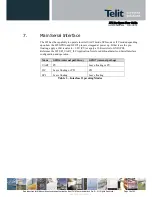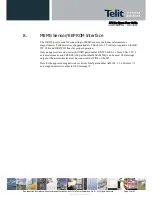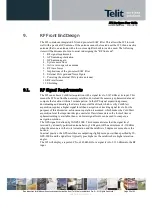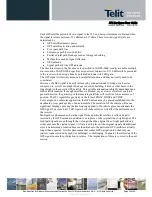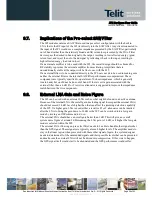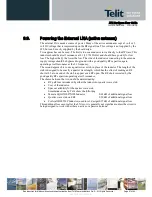
JF2 Hardware User Guide
1vv0300985 Rev.4 2013-04-09
Reproduction forbidden without written authorization from Telit Communications S.p.A. - All Rights Reserved.
Page 32 of 40
Mod. 0805 2011-07 Rev.2
11.
Firmware Configuration
The JF2 can be configured by means of firmware in order to fit better into the overall system.
This section describes certain aspects of the receiver that can be configured.
11.1.
Internal LNA
The JF2 offers two modes of operation, high gain mode and low gain mode, for the internal
LNA. The high gain mode is the default mode and provides 16 to 20dB of gain. The low
gain mode provides 6 to 10dB of gain.
In general, the high gain mode is intended for use with passive antennas, while the low gain
mode is used when there is an external LNA as part of the RF front end (e.g. active antenna).
The recommended external LNA gain is 20dB.
A version of JF2 firmware is offered for system designs that require the low LNA gain mode.
The gain mode is set by the firmware when the receiver starts up. The Tracker Config
message (OSP MID178, SID2) can also be used to change the LNA mode, but note that the
use of this message is not recommended, because an incorrect parameter could render the JF2
inoperable. Contact Telit technical support if this approach is required in your system.
11.2.
Low Power Modes
The JF2 module can be operated in one of four power management modes; Full Power,
TricklePower
TM
, Push-To-Fix
TM
, and Micro Power. The latter three of these modes offer
progressively lower power consumption profiles. Depending upon the requirements of the
system design regarding frequency of position updates and availability of GPS signals in the
operational environment, the designer can choose a mode that provides the best trade-off of
performance versus power consumption.
Each of the power management modes can be commanded using the Power Mode Request
Message (MID218), which is available as part of the OSP message set. More details
regarding low power operation can be found in the Low Power Operating Modes Application
Note.
11.2.1.
Full Power
This mode consumes the most average power, but it is the most accurate navigation mode and
supports the most dynamic motion scenarios.
11.2.2.
TricklePower
TM
This mode is a duty-cycling mode. It provides navigation updates at a fixed rate and retains a
high quality of GPS accuracy and dynamic motion response, but at a lower average power
cost as compared to Full Power operation. TricklePower mode produces significant power
savings in strong signal conditions.

